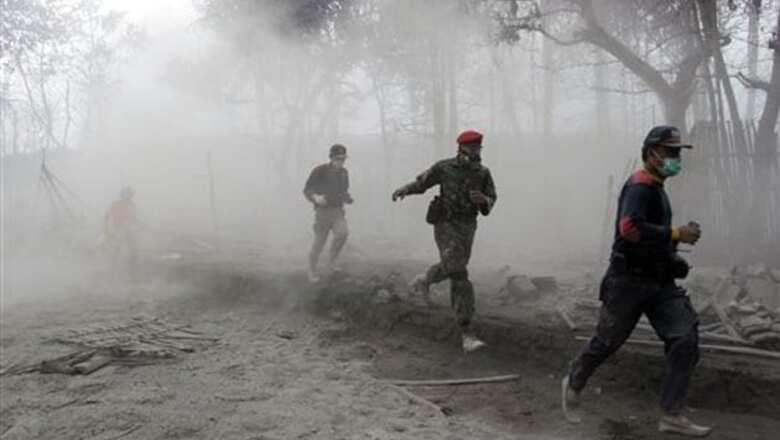
views
Mount Merapi (Indonesia): Blistering gas from Indonesia's most volatile volcano spewed farther than expected on Friday, incinerating houses at the edge of the danger zone, triggering chaotic evacuations and pushing the death toll in more than a week to nearly 100.
Soldiers joined rescue operations in Bronggang, nine miles (15 kilometers) from the mouth of the crater, pulling charred corpses from smoldering homes and then lifting them into the backs of trucks caked in gray dust.
Dozens of injured, most with severe burns, were carried away on stretchers.
"We're totally overwhelmed here!" said Heru Nogroho, a spokesman at the Sardjito hospital, as the number of bodies dropped off at their morgue climbed to 54 — the deadliest day Mount Merapi has seen in 80 years.
More than 70 others were injured, many critically, with severe burns.
Merapi's booming explosion just after midnight triggered a panicked evacuation. Men with ash-covered faces streamed down the scorched slopes on motorcycles, followed by truckloads of women and children, many crying.
Officials barked out orders on bullhorns as rocks and debris rained from the sky.
Up until Friday the village of Bronggang, home to around 80 families, was considered to be within the safety zone.
Mount Merapi, which means "Fire Mountain," has erupted many times in the last century, often with deadly results. In 1994, over a period of several days, 60 people were killed, while in 1930, more than a dozen villages were torched, leaving up to 1,300 dead.
The greatest danger is always pyroclastic flows, like those that roared down the southern slopes Friday.
Such clouds can reach temperatures of up to 1,400 degree Fahrenheit (750 degree Celsius), while racing down the slopes at speeds of up to 60 miles per hour (100 kilometers per hour).
Cities and towns more than 100 miles (120 kilometers) away were dusted.
Activity at the mountain forced an airport in nearby Yogyakarta to close Friday because runways were covered in heavy white ash. It was not clear when it would reopen, said Agus Andriyanto, who oversees operations.
Subandrio, a state volcanologist, meanwhile, said Mount Merapi's "danger zone" was extended by three miles (five kilometers) to 12 miles (20 kilometers) from the crater's smoldering mouth after the new eruption.
Even scientists from Merapi's monitoring station were told they had to pack up and move down the mountain.
Despite earlier predictions that dozens of big explosions that followed Merapi's initial Oct. 26 blast would ease pressure building up behind a magma dome, eruptions have been intensifying.
"I've never seen it act like this," said Surono, a state expert on volcanos, who has observed Merapi for more than 15 years. "We don't know what to expect."
More than 75,000 people living along its fertile slopes have been evacuated to crowded emergency shelters, many by force. Some return to their villages during lulls in activity, however, to tend to their livestock.
Indonesia, a vast archipelago of 235 million people, is prone to earthquakes and volcanos because it sits along the Pacific "Ring of Fire," a horseshoe-shaped string of faults that lines the Pacific Ocean.
The volcano's initial blast occurred less than 24 hours after a towering tsunami slammed into the remote Mentawai islands on the western end of the country, sweeping entire villages to sea and killing at least 428 people.
There, too, thousands of people were displaced, many living in government camps.


















Comments
0 comment